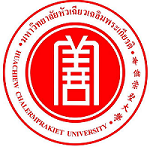Please use this identifier to cite or link to this item:
https://has.hcu.ac.th/jspui/handle/123456789/3735Full metadata record
| DC Field | Value | Language |
|---|---|---|
| dc.contributor.author | Wipada Sri-anusornsak | - |
| dc.contributor.author | Oluwatobi Kolawole | - |
| dc.contributor.author | Siriwan Soiklom | - |
| dc.contributor.author | Krittaya Petchpoung | - |
| dc.contributor.author | Kannika Keawkim | - |
| dc.contributor.author | Chananya Chuaysrinule | - |
| dc.contributor.author | Thanapoom Maneeboon | - |
| dc.contributor.author | วิภาดา ศิริอนุสรณ์ศักดิ์ | - |
| dc.contributor.author | ศิริวัลย์ สร้อยกล่อม | - |
| dc.contributor.author | กฤตยา เพชรผึ้ง | - |
| dc.contributor.author | กรรณิการ์ แก้วกิ้ม | - |
| dc.contributor.author | ชนัญญา ช่วยศรีนวล | - |
| dc.contributor.author | ธนภูมิ มณีบุญ | - |
| dc.contributor.other | Kasetsart University. Kasetsart University Research and Development Institute (KURDI) | en |
| dc.contributor.other | Wageningen University & Research. Plant Sciences Group | en |
| dc.contributor.other | Kasetsart University. Kasetsart University Research and Development Institute (KURDI) | en |
| dc.contributor.other | Kasetsart University. Kasetsart University Research and Development Institute (KURDI) | en |
| dc.contributor.other | Huachiew Chalermprakiet University. Faculty of Science and Technology | en |
| dc.contributor.other | Kasetsart University. Kasetsart University Research and Development Institute (KURDI) | en |
| dc.contributor.other | Kasetsart University. Kasetsart University Research and Development Institute (KURDI) | en |
| dc.date.accessioned | 2025-03-19T13:40:55Z | - |
| dc.date.available | 2025-03-19T13:40:55Z | - |
| dc.date.issued | 2024 | - |
| dc.identifier.citation | Molecules 2024, 29(21), 5038 | en |
| dc.identifier.other | https://doi.org/10.3390/molecules29215038 | - |
| dc.identifier.uri | https://has.hcu.ac.th/jspui/handle/123456789/3735 | - |
| dc.description | สามารถเข้าถึงบทความฉบับเต็ม (Full Text) ได้ที่: https://www.mdpi.com/1420-3049/29/21/5038 | en |
| dc.description.abstract | This research investigates the efficacy of Spirogyra sp. biomass as an effective adsorbent for the removal of AFB1 and OTA from aqueous solutions. Several factors, including contact time, adsorbent dosage, pH level, and initial mycotoxin concentration, were analyzed to evaluate their impact on adsorption efficacy. The optimal contact time for equilibrium was determined at 60 min, during which the TPA obtained a 91% reduction in AFB1 and 68% removal of OTA. Although increasing the adsorbent dosage improved effectiveness, excessive quantities led to particle aggregation, hence diminishing adsorption performance. The optimal dosage of 5.0 mg/mL optimized the efficacy and use of resources. Adsorption was more efficacious at acidic to neutral pH levels (5–6), enhancing the accessibility of functional groups on the biomass. Kinetic analysis indicated that adsorption process followed a pseudo second-order model, whereas isotherm studies demonstrated a heterogeneous adsorption mechanism, with the Freundlich model providing the optimal fit. The TPB exhibited enhanced adsorption capacities for both mycotoxins, offering a viable solution for mitigating mycotoxin contamination in food and feed. These findings illustrate the significance of biomass treatment techniques in improving mycotoxin removal efficacy and suggest the potential of algal biomass in food safety applications. | en |
| dc.language.iso | en_US | en |
| dc.subject | Spirogyra sp. | en |
| dc.subject | สไปโรไจรา | en |
| dc.subject | Adsorption | en |
| dc.subject | การดูดซับ | en |
| dc.subject | Adsorbents | en |
| dc.subject | ตัวดูดซับ | en |
| dc.subject | Algal biomass | en |
| dc.subject | ชีวมวลสาหร่าย | en |
| dc.subject | Aqueous solutions | en |
| dc.subject | สารละลายในน้ำ | en |
| dc.subject | Aflatoxins | en |
| dc.subject | อะฟลาท็อกซิน | en |
| dc.subject | Ochratoxin A | en |
| dc.subject | โอคราท็อกซิน เอ | en |
| dc.title | Innovative Use of Spirogyra sp. Biomass for the Sustainable Adsorption of Aflatoxin B1 and Ochratoxin A in Aqueous Solutions | en |
| dc.type | Article | en |
| Appears in Collections: | Science and Technology - Articles Journals | |
Files in This Item:
| File | Description | Size | Format | |
|---|---|---|---|---|
| Innovative-Use-of-Spirogyra-sp.-Biomass-for-the-Sustainable-Adsorption.pdf | 74.24 kB | Adobe PDF | View/Open |
Items in DSpace are protected by copyright, with all rights reserved, unless otherwise indicated.
